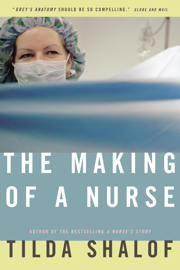
iStockphoto + Scrubs
“Brusque and sarcastic toward doctors, demanding and critical of other nurses, irreverent and dismissive toward administrators and politicians….” Don’t we all wish we had the guts to be like Laura?
The following is an excerpt from the chapter “Thinking Like a Nurse” in The Making of a Nurse by Tilda Shalof.
Within the larger team of nurses, there were six of us whom I ended up working with closely for many years. We were dubbed “Laura’s Line,” but if we had been the “Spice Girls,” Laura would have been pungent Garlic; Frances, heart-warming Cinnamon; Tracy, elemental, essential Salt; Justine, spicy Cayenne Pepper; Nicky, sweet Maple Sugar; and I, Coriander, an acquired taste that grows on you over time, or so I’ve been told.
Even back then, Laura was a paradox. Brusque and sarcastic toward doctors, demanding and critical of other nurses, irreverent and dismissive toward administrators and politicians, Laura was at all times exquisitely kind and exceedingly gentle with her patients. She was intelligent and very well read, yet she had little respect for formal education. Patients loved her, but Laura prided herself on never getting too attached to them.
“One thing I can tell you,” Laura said to me early on. We were sitting in the staff lounge during a coffee break, and she stretched out on the couch, her arms behind her head. “The personal stuff is highly overrated. I never get emotionally involved with my patients.”
“How can you care for people and not have a relationship with them?” I asked in dismay.
“I’ve taken care of a lot of patients over the years and never felt I had to get to know them,” she shot back. “Give me a break, Tilda! There are too many of them and they’re too sick and there isn’t enough time or enough of us.”
“Haven’t you noticed how it means so much to patients when nurses get emotionally involved with them?”
“Patients also tend to favour nurses who give them the right medications on time, too!”
Laura showed little deference to doctors. She addressed them all by their first names, and when a weekend was coming up, she not-too-subtly suggested that they treat the team to bagels and cream cheese or pastries. And if a resident wanted to perform a procedure on a patient and asked Laura to bring him sterile drapes, an angiocath, a scalpel and a pair of forceps, she didn’t miss a beat. “Do you want fries with that?” she’d ask.
When the doctor finished the procedure and if he should turn to walk out of the room, she would call him right back to clean up the mess of bloody towels, used swabs and especially “sharps”—the needles, wires and blades—he’d left behind. Why should she clean up his mess or risk her safety handling things he had used, she’d ask him. And just before she released him, if he had written a slew of orders in the chart, she’d stop him.
“Whoa, there. You can’t split without discussing those with me. I’m in charge of this patient’s care.” Eventually, she’d set him free and he would scurry off.
She spoke in the same way to senior staff doctors. If one of the specialists asked Laura about her patient, she might say, “That depends,” not looking up from whatever she was doing. “Tell me who you are first. If you’re from Neurology, then he’s improving. If you’re from Cardiology, he’s stable, but if you’re from the liver team, he’s in a bad way.”
Once I asked Laura about my patient’s central venous pressure.
“Where do the doctors want the CVP to be?” I asked her. By then I understood the various manipulations that we could make with fluids and medications to affect the heart’s functioning. “Where do they want it?” she shot back. “Where do you think it should be? Don’t just follow orders. Think it through yourself.”
Excerpted from The Making of a Nurse. Copyright © 2007 Tilda Shalof. Published by McClelland & Stewart Ltd. Reproduced by arrangement with the Publisher. All rights reserved.


















